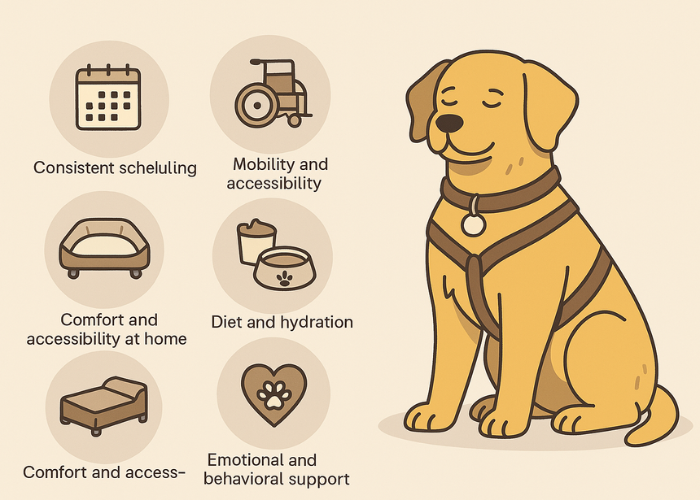Introduction
What if one day your dog starts choking or gets hit by a car — would you know what to do?
Emergencies with pets are more common than most people think. In fact, 1 in 3 pets will experience a medical emergency every year. For many owners, these moments are stressful, confusing, and — in worst cases — tragic. But it doesn’t have to be that way.
This guide is for you — a passionate dog lover who wants to be ready for anything. From spotting the first signs of trouble to administering Dog First Aid and knowing when to rush to the vet, you’ll be better prepared to respond with confidence. Being proactive could be the key to saving your dog’s life.
Recognizing a Canine Emergency
Early intervention can make the difference between life and death. But before you can help your dog, you must know when something is seriously wrong. Below are common signs that indicate an emergency:
- Labored or fast breathing
- Excessive bleeding or bleeding that won’t stop
- Seizures or convulsions
- Unconsciousness or collapse
- Bloating (swollen abdomen)
- Inability to walk or sudden paralysis
- Prolonged vomiting or diarrhea (especially with blood)
- Pale or bluish gums
- Obvious pain, whimpering, or signs of distress
A general rule: if your gut tells you something is wrong — act. Dogs are great at hiding pain, and delaying action could make things worse.
The Must-Have Dog First Aid Kit
A good Dog First Aid kit is your best line of defense when time is critical. You don’t need anything fancy — just the right tools, easily accessible. Here’s a comprehensive list:
Basic Supplies
- Gauze pads and non-stick bandages
- Adhesive tape
- Cotton balls and swabs
- Tweezers and blunt-tip scissors
- Digital thermometer (normal dog temp: 101–102.5°F)
Medications & Solutions
- Hydrogen peroxide (3%) – only use to induce vomiting when instructed by a vet
- Saline solution – great for flushing wounds and eyes
- Antiseptic wipes or solution (chlorhexidine or betadine)
- Styptic powder – helps stop minor bleeding
Protective Gear
- Muzzle (dogs in pain may bite)
- Latex or nitrile gloves
- Blanket or towel (for transport or warmth)
Other Essentials
- Flashlight
- Emergency vet contact info
- Copy of dog’s medical history and vaccinations
- Leash, collapsible bowl, and treats (to calm your pet)
💡 Pro Tip: Create a travel-sized version of this kit for your car. Emergencies don’t wait for you to get home.
Common Dog Emergencies You May Face
Let’s look at scenarios where Dog First Aid can be the critical difference:
1. Choking
Signs: Pawing at mouth, gagging, wheezing, blue gums
What to do: Open mouth, sweep visible objects. If dog is unconscious, perform the Heimlich maneuver — with care.
2. Heatstroke
Signs: Excessive panting, drooling, vomiting, lethargy
What to do: Move to shade, wet paws and belly with cool water, offer water. Never use ice-cold water — it may shock the system.
3. Poisoning
Common toxins: Chocolate, grapes, xylitol, medications, cleaning products
Signs: Vomiting, tremors, seizures, unsteady gait
What to do: Call a vet or poison control. Do not induce vomiting unless instructed.
4. Cuts and Bleeding
Signs: Obvious wound, continuous bleeding
What to do: Apply direct pressure with clean gauze. Use a bandage once bleeding slows. If it bleeds through, don’t remove — add layers and go to the vet.
5. Burns
Signs: Red, blistered, or charred skin
What to do: Cool the area with water, avoid ointments unless vet-approved. Cover loosely with a clean cloth.
Dog First Aid in Action: A Step-by-Step Guide
Here’s how to stay composed and effective in a real emergency:
- Stay calm and assess the environment. Remove your dog from danger (road, fire, etc.) if it’s safe.
- Protect yourself. Even the gentlest dog may bite if in pain.
- Check breathing and pulse. Look for chest movement. Feel behind the elbow for a heartbeat.
- Administer CPR (if necessary):
- Small dogs: 100-120 compressions per minute
- Large dogs: 80-100 compressions per minute
- Give 2 rescue breaths for every 30 compressions
- Stop any bleeding. Apply pressure for several minutes.
- Call your vet. Give clear, calm information. Ask for instructions before transporting your dog.
- Stabilize for transport. Use a towel or flat board to move the dog if needed.
⏱️ Timing is everything. Even 2–3 minutes of effective first aid can be lifesaving.
Important Facts and Stats
Understanding the real risks helps you take Dog First Aid seriously:
- 90% of pet owners are not prepared for a canine emergency.
- Over 60% of accidents happen at home or nearby.
- Only 6-10% of dogs survive cardiac arrest, but that rate doubles with immediate CPR.
- More than 232,000 pet poisonings are reported annually in the U.S. alone.
These numbers highlight a truth: knowledge is power — and in emergencies, it’s life-saving power.
Advanced Tips for Better Preparedness
Want to go beyond the basics? Here’s how to take your readiness up a notch:
- Take a certified pet first aid course. Organizations like the American Red Cross offer online and in-person training.
- Have an emergency evacuation plan that includes your pets.
- Keep multiple kits. One at home, one in the car, and one with your dog’s walker or sitter.
- Label everything in your kit and add short instructions inside.
- Know your dog’s normal. Record your dog’s usual temperature, breathing rate, and behavior to recognize changes quickly.
🧠 A little planning today can save you from panic tomorrow.
Bonus: Situations That Look Serious But Aren’t
Not every symptom is a crisis. Here are a few things that seem urgent but usually aren’t, though still worth monitoring:
- Reverse sneezing: Often sounds scary but is harmless
- Mild limp after exercise: Can be due to sore muscles
- Hiccupping or burping: Usually digestion-related
- Eating grass: Sometimes normal, unless accompanied by vomiting
That said, when in doubt — call the vet. It’s always better to be safe than sorry.
Conclusion: Be the Lifesaver Your Dog Needs
You don’t need to be a vet to save your dog’s life — you just need to be prepared.
This guide on Dog First Aid isn’t just about reacting to accidents. It’s about becoming a more confident, capable, and loving dog parent. Emergencies are frightening, but with knowledge, you turn fear into focus.
So here’s your action plan:
✅ Build your first aid kit
✅ Learn CPR and emergency signs
✅ Practice and review your plan regularly
🎯 Don’t wait until it’s too late.
Be the hero your dog already believes you are.



